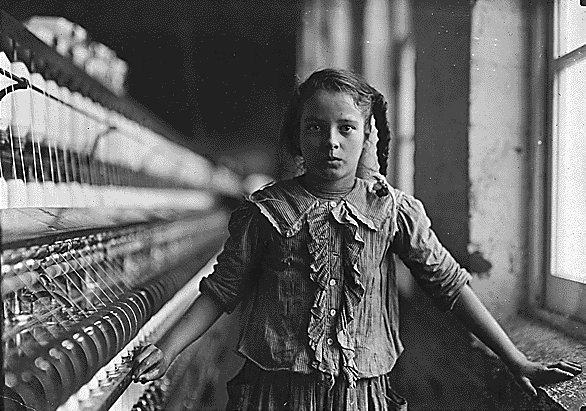by Lila Rose and Philip Gerard Johnson
Throughout history, images have been used to make the public aware of atrocities and injustices. In 1785, Thomas Clarkson began to examine the morality of the British slave trade while competing in an essay contest. After much research, including interviews with those involved in the slave trade, he devoted the rest of his life to ending slavery. In his anti-slavery pamphlets, Clarkson included images of shackles, branding irons, and ships carrying captured Africans. These images exposed the horrors of slavery to the public, and slavery in Great Britain was finally abolished in 1807 with the “Slave Trade Act.”
In 1908, photographer Lewis Hine began using photography to expose the cruelty of the child labor industry. In collaboration with the National Child Labor Committee, Hine photographed daily life in steel and glassmaking factories throughout the country. He presented his images in magazines, posters, and through public exhibits in order to expose the dangerous working conditions of his time. One social historian commented that Hine’s photography “[brought] into view what normal social vision has been conditioned to ignore.”[1]
Most Americans can recall images presented to us as children depicting the persecution of African Americans in the Civil Rights movement. From policemen attacking protestors with fire hoses and police dogs, to murdered African Americans hanging in trees, these “graphic” images continue to be used as a form of education and as a constant reminder of what our “civilized human race” is still capable of doing.
The murder of Emmett Till helped mobilize the American Civil Rights Movement. Accused of whistling at a white woman, fourteen-year-old Till was beaten beyond recognition, shot in the head, and thrown into the Tallahatchie river. His mother chose to invite the public and media to Emmett’s funeral, and allow the press to take photographs. Mrs. Till also chose to leave her son’s casket open. Millions were enraged by the murder of the young boy, especially after seeing the widely publicized photo of Emmett’s mangled face. Mrs. Till told the media, “I want the whole world to see what they did to my baby.”
If only those same words could be heard today as 3,700 babies are torn from their mothers’ wombs every day. Unlike those who bravely showed images from steel factories and the Civil Rights movement, many are reluctant to show images of the victims of abortion. The result is a widespread ignorance of the magnitude of this “silent genocide,” but we must not remain silent any longer. If the world were to see the victims of abortion, would so many still be willing to tolerate it?
[1] Judith Mara Gutman, Lewis W. Hine and the American Social Conscience (New York: Walker and Company, 1967), 25.










